MARIANI’S
Virtual
Gourmet
March 26,
2023
NEWSLETTER
ARCHIVE
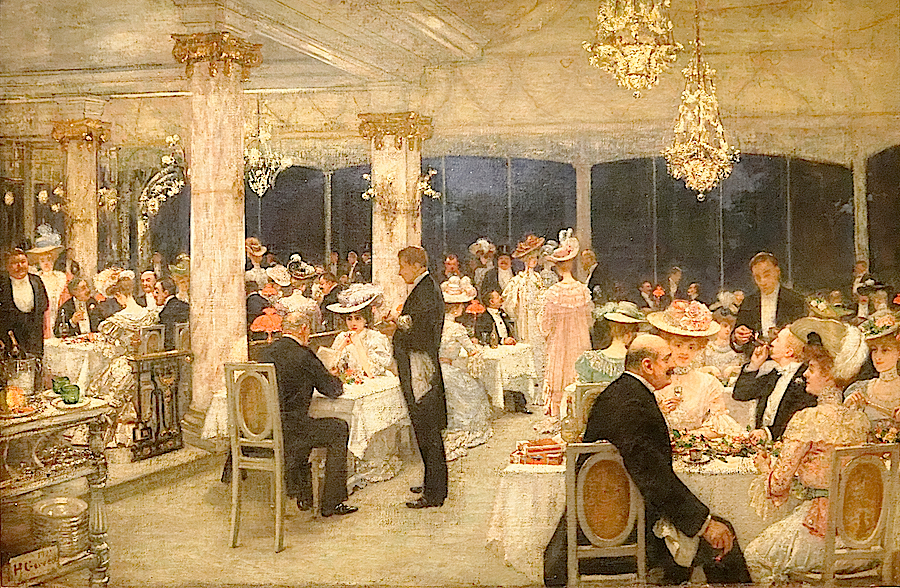
"Une Soir de Grand Prix au Pavillon d'Armenonville" By Henri Gervex (1905)
THIS WEEK
THREE BAROQUE PUGLIAN CITIES
By John Mariani
NEW YORK CORNER
BENJAMIN STEAKHOUSE
By John Mariani
GOING AFTER HARRY LIME
CHAPTER 13
By John Mariani
NOTES FROM THE SPIRITS LOCKER
POST-ST.
PATRICK'S DAY,
LET'S LOOK AT IRISH WHISKEYS
By John Mariani
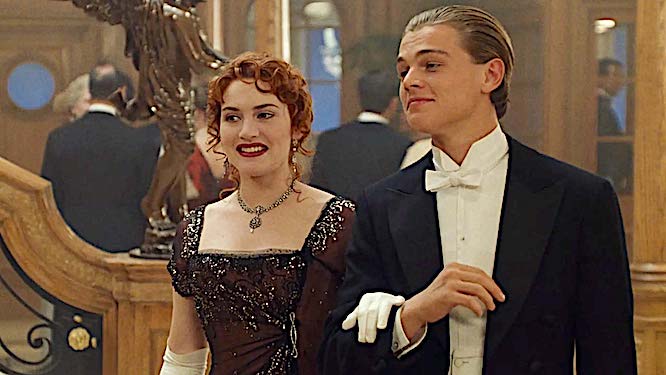 WVOX.com.
The episode will also be archived at: almostgolden.
WVOX.com.
The episode will also be archived at: almostgolden.
THREE BAROQUE PUGLIAN CITIES
By John Mariani
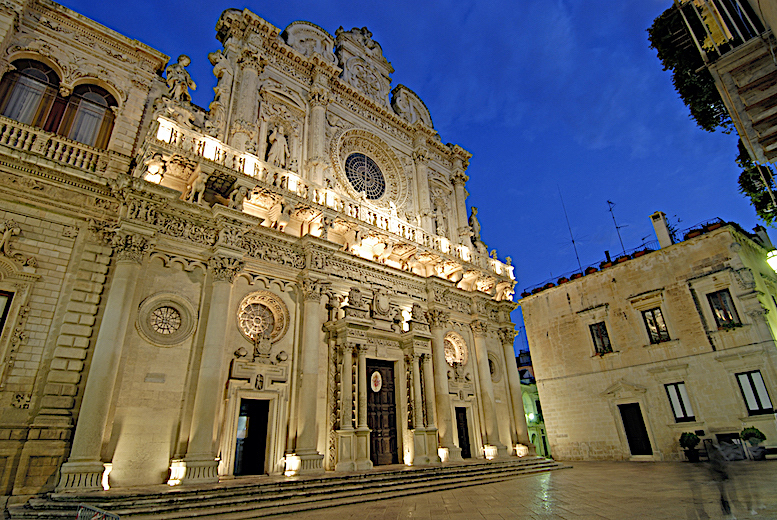
Basilica di Santa Croce in Lecce
The
Italian Baroque period flourished in the
South more than in the North, but, while
many would suppose that Naples exhibits the
grandest face of that flamboyant style, it
is in Puglia where it is most exemplary in a
finer tone. So, too, the food of the region
has been adapted to a modern style
showcasing the seafood and ingredients of
the region.
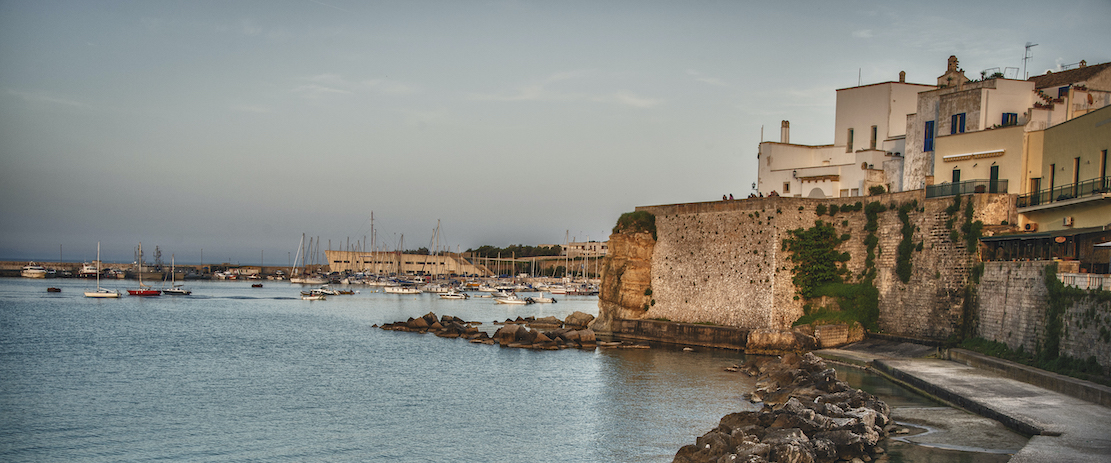 Otranto,
like so many towns on the coast of the
Adriatic, located in the shadow of the massive
Castello Aragonese, was always ripe for
invasion and rule by others, including the
Byzantines, Ottomans and French, since the
late 15th century. Its
most magnificent sight is the Cathedral, begun
in 1088 and home to extraordinary mosaic
floors throughout. The first Gothic novel took
place there:
The
Castle of Otranto by English author
Horace Walpole.
Otranto,
like so many towns on the coast of the
Adriatic, located in the shadow of the massive
Castello Aragonese, was always ripe for
invasion and rule by others, including the
Byzantines, Ottomans and French, since the
late 15th century. Its
most magnificent sight is the Cathedral, begun
in 1088 and home to extraordinary mosaic
floors throughout. The first Gothic novel took
place there:
The
Castle of Otranto by English author
Horace Walpole. 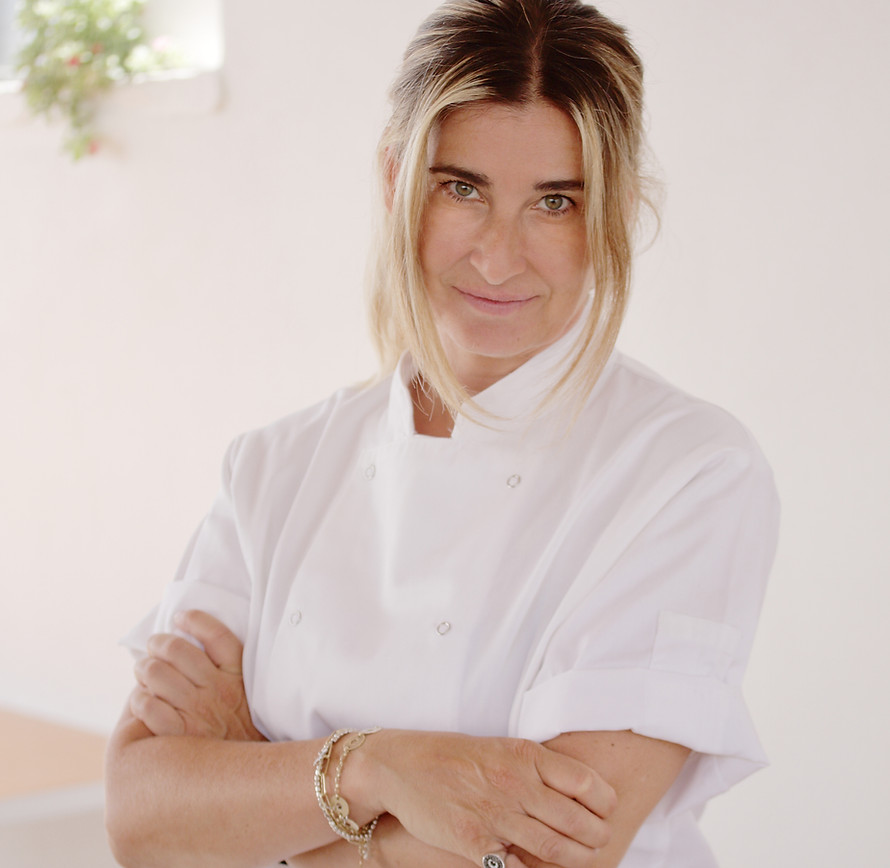
The great pleasure of Otranto is
walking its seaside walls at dusk and
twilight, then to enter its maze of
romantically lighted streets. Near
the Cathedral is one of the city’s finest
restaurants, L’Altro Baffo, whose name, “the
Other Baffo,” refers to how Cristina Conte
left her father’s very traditional ristorante,
Al Boffo, to offer her own take on regional
cuisine.
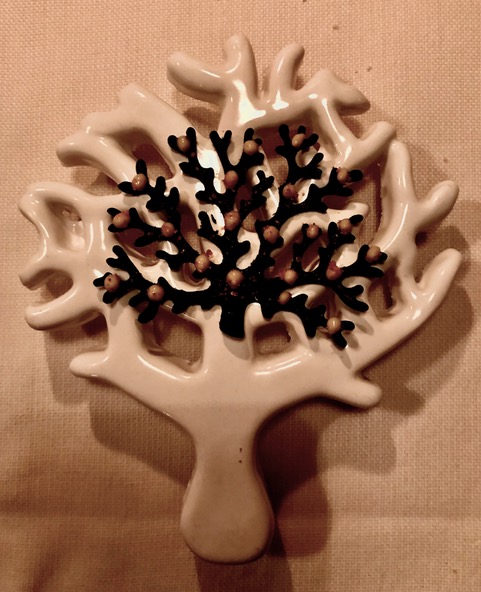 Within the
kitchen she’s hired cooks from the Far East
and Africa, who have influenced her daring
style, best appreciated in the fixed price
menu of 80€ (à la carte also available), which
on the night I visited included crudi
of the day’s fish (25€); maccheroni
with redfish and a white fish sauce,
dusted with Mediterranean powders (29€);
mussels with a gratin of breadcrumbs and
pecorino (14€); linguine with anchovies and
red sponzale
onions (20€); croaker with foie gras and
fermented cabbage (23€); local lobster with cicala shrimp
(15€); and for dessert cannoli stuffed with
preserved fruits and orange foam (9€).
Everything is presented on individual china,
some dishes on skewers, so that it is all
unique to Conte’s creativity.
Within the
kitchen she’s hired cooks from the Far East
and Africa, who have influenced her daring
style, best appreciated in the fixed price
menu of 80€ (à la carte also available), which
on the night I visited included crudi
of the day’s fish (25€); maccheroni
with redfish and a white fish sauce,
dusted with Mediterranean powders (29€);
mussels with a gratin of breadcrumbs and
pecorino (14€); linguine with anchovies and
red sponzale
onions (20€); croaker with foie gras and
fermented cabbage (23€); local lobster with cicala shrimp
(15€); and for dessert cannoli stuffed with
preserved fruits and orange foam (9€).
Everything is presented on individual china,
some dishes on skewers, so that it is all
unique to Conte’s creativity.
Lecce is one of Italy’s
oldest (2,000 years), most beautiful and
richly Baroque cities, called the “Florence of
the South,”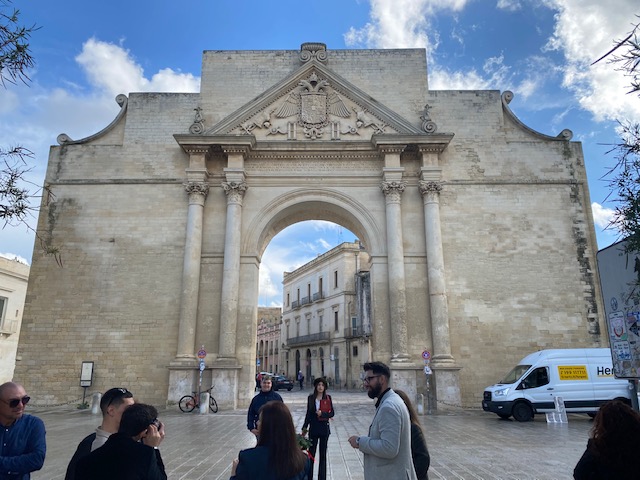 entered
through its old triumphal portal (1548) onto
broad streets whose buildings are made of a
cream-colored limestone called “Lecce stone”
that is easy to carve (they also used papier
mâche for some of the effects.) Its Church of
the Holy Cross is an astonishment of filigree
adornment, completed in 1695. As a university
town, it has been home to a broad array of
famous Italians in the last century.
entered
through its old triumphal portal (1548) onto
broad streets whose buildings are made of a
cream-colored limestone called “Lecce stone”
that is easy to carve (they also used papier
mâche for some of the effects.) Its Church of
the Holy Cross is an astonishment of filigree
adornment, completed in 1695. As a university
town, it has been home to a broad array of
famous Italians in the last century.
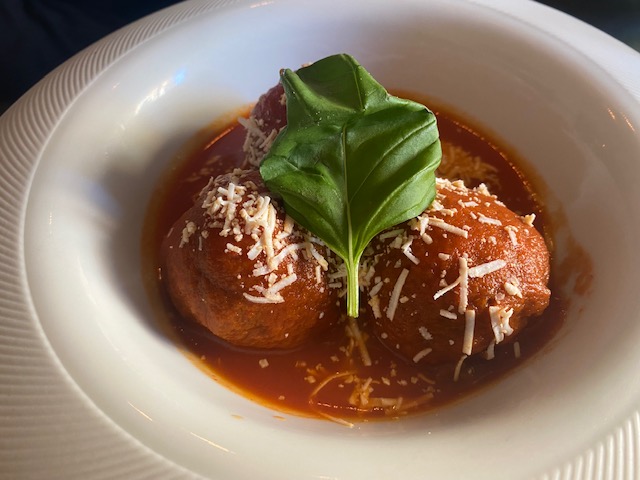 One of its most delightful,
remarkably inexpensive trattorias
is the five-year-old La
Cucina di Mamma Elvira, a casual and
very cheery place, rustic and busy. The food
is wholly dependent on first-rate ingredients
like the lustrous prosciutto and capicola
(14€), the creamiest of burrata (a Puglian
specialty), pureed fava beans and chicory (7€)
and terrific meatballs with a rich tomato
sauce (14€).
One of its most delightful,
remarkably inexpensive trattorias
is the five-year-old La
Cucina di Mamma Elvira, a casual and
very cheery place, rustic and busy. The food
is wholly dependent on first-rate ingredients
like the lustrous prosciutto and capicola
(14€), the creamiest of burrata (a Puglian
specialty), pureed fava beans and chicory (7€)
and terrific meatballs with a rich tomato
sauce (14€). 
Galatina is a mid-size town with a
modest Baroque center with a late Romanesque
church dedicated to Saint Catherine with very
fine frescoes by Francesco
d’Arezzo.
Here is one of the most modern
restaurants of the region, Stella
del Mare (below), which actually
dates back 100 years as a fish shop, now run
by the third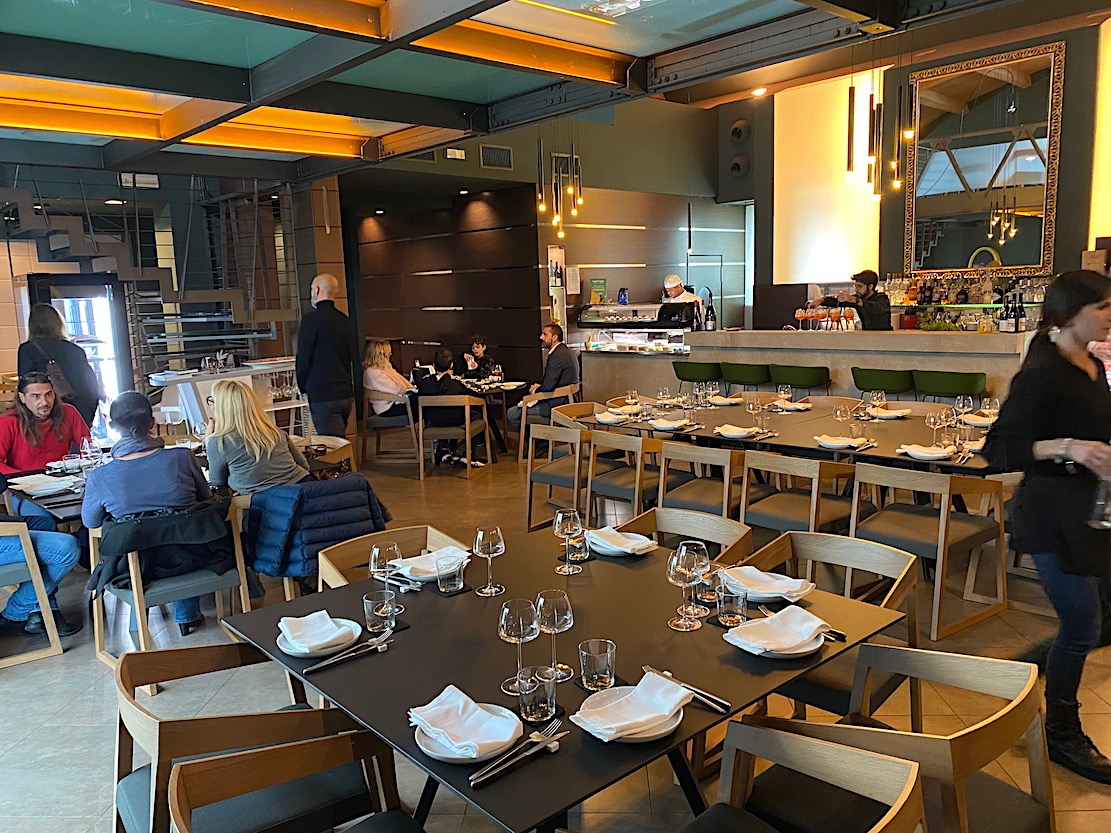 generation Mino and
Martina d'Amato. It’s set on two levels with a
wide open kitchen, and there is a blackboard
menu listing the day’s specials that are
smoked in a special glass enclosure.
generation Mino and
Martina d'Amato. It’s set on two levels with a
wide open kitchen, and there is a blackboard
menu listing the day’s specials that are
smoked in a special glass enclosure.
You begin with fried lentils that are
like popcorn and some fritters of chickpeas
called pettule
to munch on. There is also a long sushi
section of the menu (in English), with dozens
of species from 12 to 15€. There are menu
tasting options at 25€, 30€ and 40€.
Everything is done with dazzle,
including risotto with smoked green tea and a
tartare of shrimp (22€); a carbonara style of
blue fish (18€); gnocchi with a ragù of dentice
(18€); monkfish with lentils and lardo
fat (20€); paccheri
pasta with octopus ragù; and linguine with sea
urchins (22€).
Food
of the kind I’ve described here would not be
found outside of Puglia—some of the seafood
species would be a rarity—and prices are very
gentle everywhere. A splurge with wine (tax
and service included) would be half the price
it would in Florence, Venice or Rome, and the romantic
baroque all around you is free.
❖❖❖
NEW YORK CORNER
BENJAMIN’S STEAKHOUSE
52 East 41st
Street
212-297-9177
By John Mariani
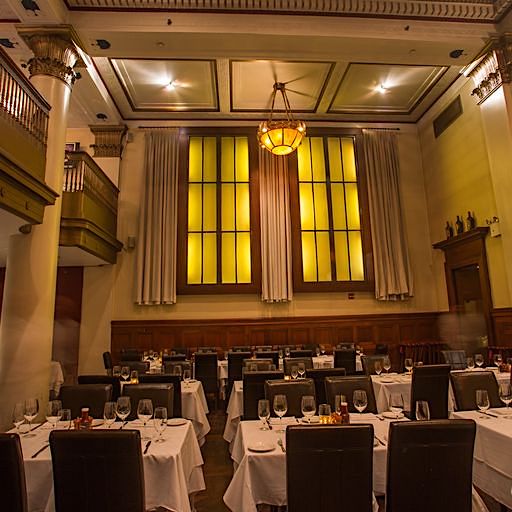
An old
German proverb says, “If everything be
done twice, everything would be done
better.” Imagine then, if everything
were done a thousand, ten thousand or a
hundred thousand times with all due
diligence, how marvelous something could
be. More than any kind of restaurant, an
American steakhouse is capable of such
feats of consistent excellence, even
with a broad menu. Unless complacency
creeps in,
repeating and tweaking items as
humble as onion rings and creamed
spinach thousands of time each week is
going to pretty much assure they are
every bit as good this year as last or
next.
 Of course, the argument begins and
ends with great beef of a kind that USDA
Prime used to be the epitome.
Alas, no longer, since that rating is now
stamped on meat that would once have been
considered mere Choice.
Of course, the argument begins and
ends with great beef of a kind that USDA
Prime used to be the epitome.
Alas, no longer, since that rating is now
stamped on meat that would once have been
considered mere Choice.
The beef once only available in the
best New York steakhouses like Peter
Luger, Palm and Christ Cella is now rarely
found outside of the city, least of all in
the national chains (that now, sadly,
includes the Palm). Fortunately, there are still
steakhouses
in New York that compete at the highest
level to obtain the finest beef, and
Benjamin’s Steakhouse—whose owners Benjamin
Prelvukaj and Ben Sinanaj both used to
work at Luger—is among the very finest. 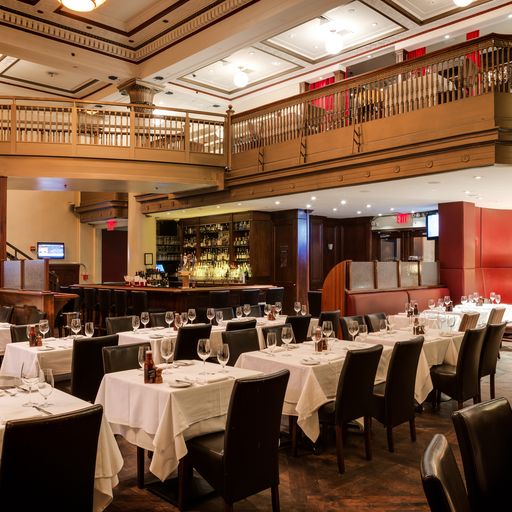
Taking along one of Luger’s chefs,
Arturo McLeod, they opened just south of
Grand Central Terminal in 2006 and
subsequently just east of the New York
Public Library (people often confuse the
two upon walking in). They now have
another close by, called Benjamin Prime,
and one in White Plains, as well as a
first-rate seafood restaurant, The SeaFire
Grill on East 58th Street.
The two men took over the
magnificent Chemist Club building, opened
in 1911 as a private enclave for chemists
and researchers, which closed in 1987 to
become the Dylan Hotel. Its former
boardroom, with its splendid mezzanine, is
now the main dining room, with 175 seats,
with party rooms located in other historic
spaces.
The steakhouse setting fits in
impeccably with well-set tables topped
with double white cloths, fine stemware
and good lighting. The noise level can be
problematic, unless you’re lucky enough to
score one of the recessed curved
banquettes. (You can always ask.) And
unlike the sit-`em-and-move`em service at
many other steakhouses around town,
manager John Martinaj and company try very
hard to welcome everyone, despite the
crush at the host station.
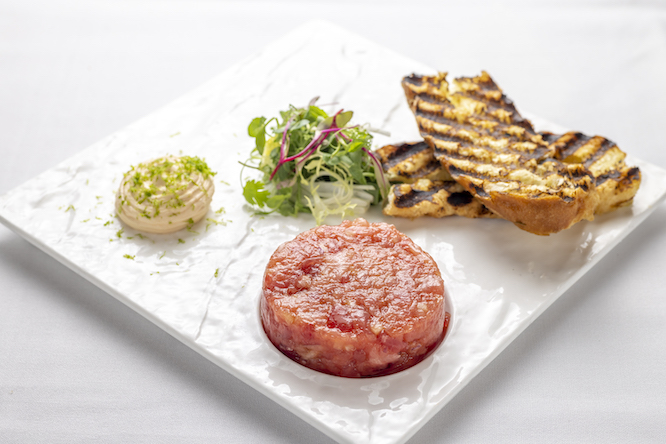 There
are civilized touches: generous pats of
butter and a dish of olive oil to go with
the bread, rolls and sesame crackers;
large plates heated to keep the food warm;
when I asked for more dressing for my
salad, the waiter brought not one, but
two, ramekins.
There
are civilized touches: generous pats of
butter and a dish of olive oil to go with
the bread, rolls and sesame crackers;
large plates heated to keep the food warm;
when I asked for more dressing for my
salad, the waiter brought not one, but
two, ramekins.
The wine list is extraordinary,
which in New York it needs to be in face
of the competition around town. Victor Dedushaj
is the wine director for all the
restaurants. He said that Prime has
about 1,000 different wines, Benjamin
Steakhouse about 600, SeaFire about 700
and White Plains about 1,000. And he
said they have about 200 different
liquors. Cocktails are also expertly and
generously made.
There’s
little on the menu you can’t find
elsewhere, but the signature Benjamin
salad ($25.95 for two), made with two
greens, red onion, apple and a good amount
of lump crabmeat, is outstanding. That
same sweet crab goes into the crab cake
($29.95) without too much filler (above).
Baked clams are fat and juicy ($18.95),
not dried out by overcooking, and the tuna
tartare ($26.95) was finely cut from
excellent quality tuna bound with just the
right amount of seasonings to make it
spark. Benjamin’s soup ($17.95) of ground
beef, potatoes and onions comes topped
with puff pastry, almost like a pot pie.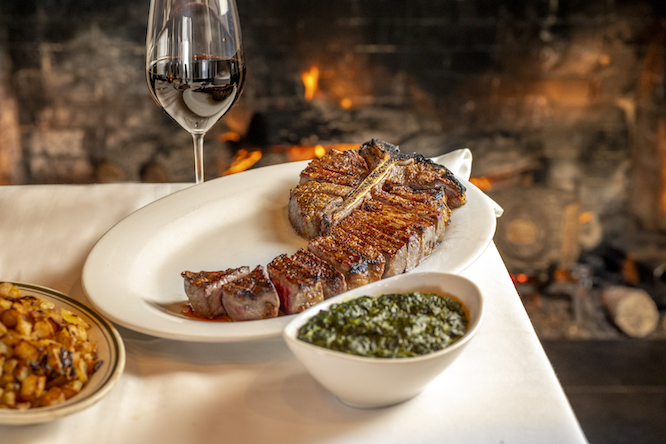
As already noted, Benjamin’s has
top quality USDA dry-aged Prime beef and
it is cooked to perfection, with a fine
exterior char and an interior that oozes
juices and buttery goodness. You can order
it for two ($134.95), three ($202.95) or
four ($269.95), with the bone, and a good
portion of ours ordered for two went home
with us that night. The Colorado rack of
lamb ($64.95) is a hefty array of equally
well-cooked meat whose bones have some of
the tastiest bits. I applaud Benjamin’s
for not even bothering to serve wagyu,
whether facsimiles or true Kobe, because
US Prime beef has so much more flavor than
those cloyingly fatty cuts.
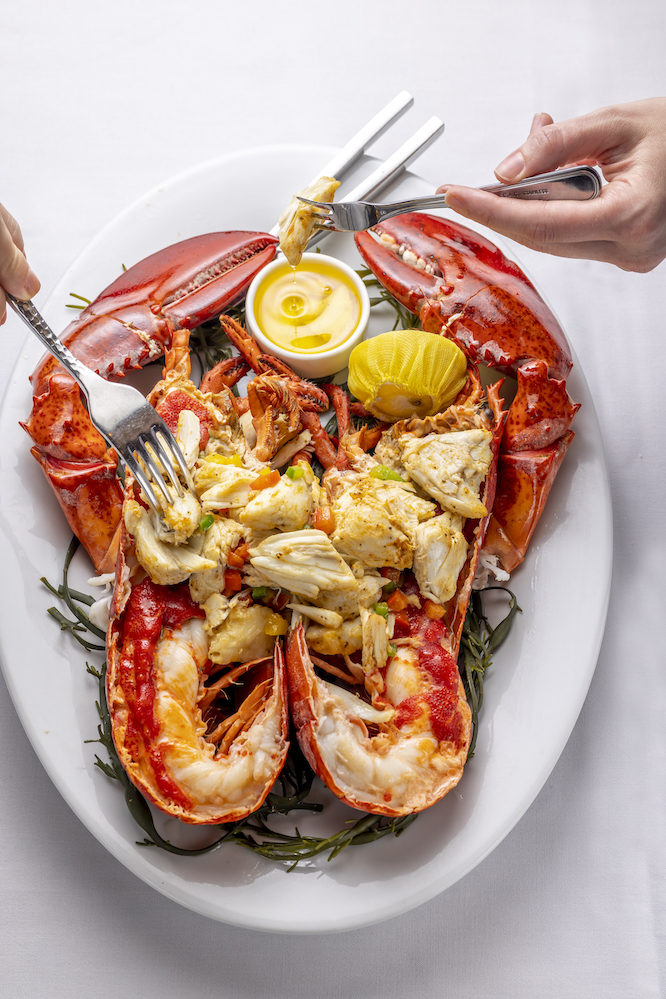 Beef
houses vary when it comes to serving
lobsters, and not all do. Benjamin’s does,
and a three-pounder (MP) was brought to
the table steaming hot and remained so as
the waiter deftly cracked its shell and
removed the sweet meat with dispatch. (So
often elsewhere this ritual takes so long
that the lobster cools down.)
Beef
houses vary when it comes to serving
lobsters, and not all do. Benjamin’s does,
and a three-pounder (MP) was brought to
the table steaming hot and remained so as
the waiter deftly cracked its shell and
removed the sweet meat with dispatch. (So
often elsewhere this ritual takes so long
that the lobster cools down.)
Benjamin’s home fries ($15.95) are
the potato dish to have, as are the rich
creamed spinach ($15.95)
and exemplary onion rings ($16.95).
Pace yourself but do have one of
the sumptuous desserts, like the
cheesecake ($11.95) or chocolate
soufflé ($13.95).
Benjamin is
not unique in New York—after all, it has a
branch nearby—but in a city whose
steakhouses compete so intensely so as to
keep their menus similar and their prices
in line, it stands out among the very best
in its league. Add to that the cordiality
of the service—not always a given
elsewhere—and the careful coordination
among host station, captains, bar, kitchen
and waitstaff and Benjamin’s is a good
template for all newcomers to try to meet.
Open for breakfast,
lunch and dinner Tues.-Sat.
GOING AFTER HARRY LIME
By John Mariani
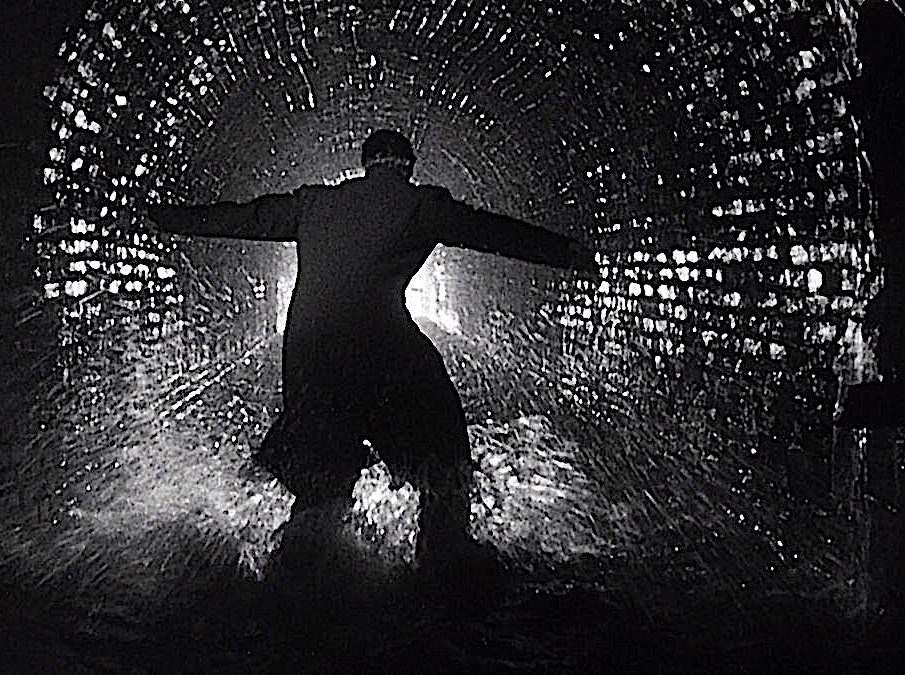
CHAPTER
THIRTEEN
“What
did you want me to do? Be reasonable. You didn't
expect me to give myself up ... 'It's a far, far
better thing that I do.' The old limelight. The
fall of the curtain. Oh, Holly, you and I aren't
heroes. The world doesn't make any heroes
outside of your stories.” — Harry Lime,
The Third Man.
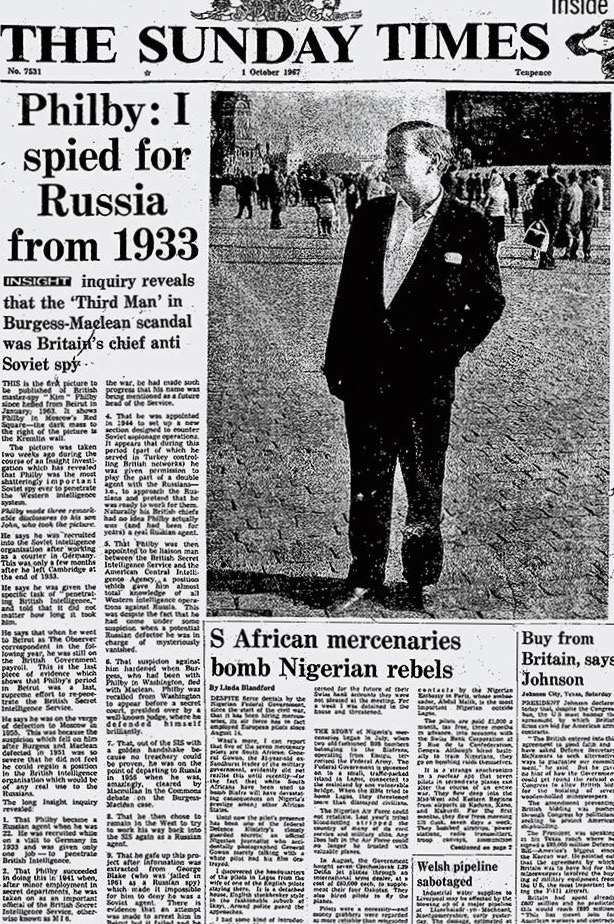 The
phone
rang in David’s room at 1 a.m., when he was dead
asleep.
The
phone
rang in David’s room at 1 a.m., when he was dead
asleep.
“Hello, who’s this?” he asked.
“Frank English. You called me.”
David shook himself awake, then saw it was
past midnight. What was that in Washington? Six,
seven o’clock? He figured Frank English knew and
called late enough just to bug him.
“Yeah,” said David, “thanks for calling
back, Frank.”
“Whaddaya want this time?”
“A name, a number, whatever you can give
me.”
“About what?”
“I’m over here in London with Katie Cavuto
working on a story. You know the movie The Third Man?”
“Sure.” English was giving no more to the
conversation than he chose to.
“Well, we’re over here trying to find out
if there was a possible connection between the
Harry Lime character in the movie and the British
double agent Kim Philby. It’s farfetched but worth
looking into.”
There was silence on the other end, and
David knew English was trying to put things
together. Then the FBI agent said, “About as
farfetched as you can get. That bullshit has been
gone over before, and besides, Philby’s been dead
for a long time. What do you want from me?”
“Well, I was speaking with Gerry Kiley and
he said that there’s no way I’m going to get any
dossier intel on Philby merely because I’m over
here snooping around.”
“You got that right. Why would they talk to
an ex-cop from NYPD about a burnt out case?”
“OK, MI6 and MI5 wouldn’t. I get that. But
is there perhaps some ex-MI6 or
MI5 agent you might have worked with—”
English cut him off: “Hey, David, I wasn’t
around in the 1940s to know any of those people,
so I don't know what J. Edgar Hoover would have
known. Plus, the C.I.A. didn’t even exist until
1950,
and Hoover hated the whole idea of working with
them.”
“True, but the C.I.A. was around when
Philby was exposed as a double agent in ’63.”
“Yeah, but I think they were a bit busy
with plans to invade Cuba back then and not
interested in what happened to some toothless
British turncoat.”
“So, you don’t know anyone?”
More silence. “I don’t know. Let me ask a
few of the older guys here. If I find something,
I’ll call you back.”
David, trying to lighten up, said, “Could
you make it at a daytime hour in London? It’s
after one o’clock in the morning.”
“Yeah, I know,” said English. “I’ll call
you when I get in tomorrow morning, which will be
like, two in the afternoon for you.”
“Thanks, Frank. I appreciate it.”
English had already clicked off.
*
*
*
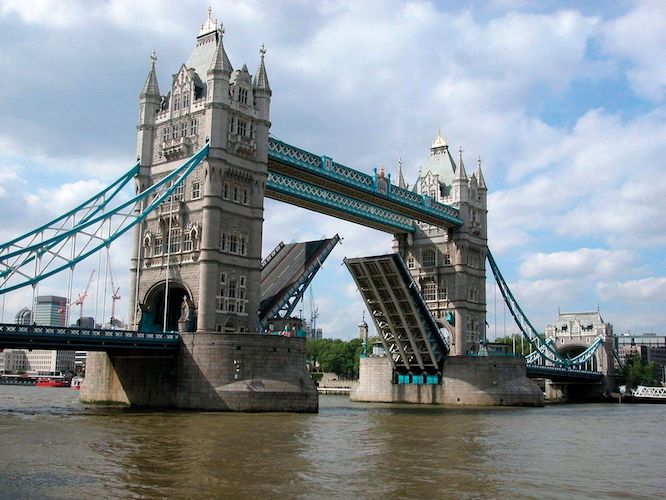
The
next
morning David thought of going back to the
National Archives, but over breakfast with Katie
she said, “Let’s just take the day off. See some
sights. I haven’t gotten any appointments, do
you?”
David said all he had to look forward to
was a call-back from Frank English.
“So, where do you wanna go?” he asked.
“The usual tourist must-sees: the Queen’s
palace, Tower Bridge, Big Ben. Whatever we see, we
see.”
“Fine, but I have to be back at the hotel
around two when Frank might call.”
“Okay, that gives us four, five hours. I’m
wearing walking shoes.”
“Then let’s go for a walk. Let’s bring
umbrellas. The sun’s out but you never know."
The couple spent the morning as Katie had
suggested, marveling at the majesty of London’s
royal buildings, the sweep of the Thames beneath
the bridge, and the vast stretch of the
Parliament, newly scrubbed clean to a putty color
that grew orange in twilight.
After a quick pub lunch, David returned to
the hotel before two and waited for Frank English
to call. An hour went by, then another, then the
phone rang.
No
hello, just, “I’ve got a name and contact for you.
May be worth nothing, but it’s all I could get.”
“I appreciate it, Frank,” said David, a pen
and paper at the ready.
“I don’t know this guy, but apparently he
was involved with the Philby scandal and may have
some inside information. Retired ages ago from MI6
and lives outside of London. Name is Southey,
Joseph Southey. Here’s his number.”
David wrote it all down and repeated it.
“Thanks, Frank. I’ll put you in my
memoirs.”
“I’ll pay you to keep me out of them. So
long, David.”
David shut his eyes for a moment, thinking
maybe he and Frank were back on track and that
Joseph Southey might help turn over some new
information from inside MI6.
He called Katie, who had just gotten back
to her room, and told her the news.
“That’s great!” she said. “So, Frank
English is a pretty good guy after all.”
“I guess so,” said David, “at least out of
professional courtesy. Okay, so let me call this
guy and ask if we can see him tomorrow. See what
it turns up.”
As a reporter Katie knew that while every
contact and interview did not reveal a great deal,
there was always something to fill in the big
picture, like the tiny piece of blue sky in a
jigsaw puzzle landscape. She was holding out hope
that, with all the pieces coming together, the
picture would reveal a good story line for her
work.
David dialed Joseph Southey’s number, which
rang six times before a man picked up.
“Southey,” said the voice.
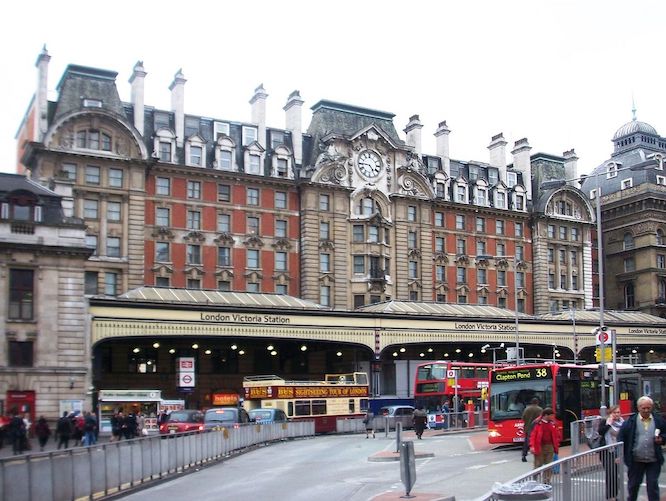 “Mr. Southey, my name is David Greco. I’m
an American over here in London, and I was given
your name by an associate in the F.B.I.” David
shouldn’t have said ‛associate’
but let it go.
“Mr. Southey, my name is David Greco. I’m
an American over here in London, and I was given
your name by an associate in the F.B.I.” David
shouldn’t have said ‛associate’
but let it go.
“And how might I help you, Mr. Greco?”
David launched into a brief, well-rehearsed
explanation of what he was after, acknowledging
that it was a highly unusual request but that he
and Katie were merely trying to find out
information about the late Kim Philby, whom they
understood Southey knew.
Southey was quiet, then said, “Well, I
can’t imagine what more I can tell you about the
rotter. Most everything was in the papers and in
books ever since, including Philby’s own
completely delusional autobiography.”
“Well, my colleague, her name is Katie
Cavuto, has done a lot of research on Philby and
still has some questions we thought you might be
able to answer.
Would it be all right if we paid you a
visit at your convenience?”
“Oh, I suppose so. The Philby case was shut
a long time ago and he’s been dead for years. I
live in Hornchurch, Essex, about an hour out of
Victoria Station (above) via the Underground. What
time is it now? Nine. All right, catch any train
and I’ll be here all day. Probably be out back in
the garden.”
“You’re a gardener, Mr. Southey? So am I,”
said David, hoping to hold the man’s interest.
“Well, then, even if I can’t tell you
anything about Kim Philby, we’ll have something to
chat about, won’t we?”
David hung up and called Katie. “We’re
in.Gotta catch a train to some place called
Hornchurch. You ready for a trip to the country?”
David was holding out hope that Southey
could add new info to what they already had. At
the very least another puzzle piece or, as Katie
called it, background color. David began to think
that even if Katie could prove Philby was not the
inspiration for Harry Lime, that alone would be
something.
But Katie knew that would not be nearly
enough.
*
*
*
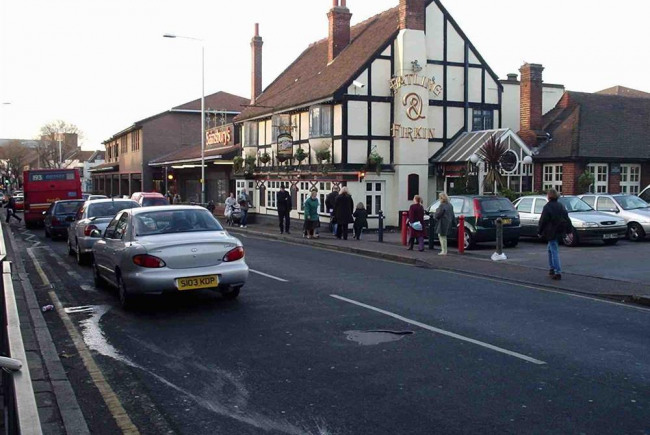
Like
most
regions not far from London, Hornchurch began as
farm country, shifted to industry in the 19th
century, then, with the arrival of the electrified
railway—the District
Line—in the 1930’s, developed into a suburb with a
large commuter segment. Typical of such towns,
most postwar homes were an amalgam of cheap
materials cobbled onto the most egregious clichés
of fake Tudor architecture, with long row houses
interrupted by pubs of unflinching sameness and
names seemingly picked at random out of The
Canterbury Tales, like The Wife of Bath and
The Tabard Inn.
The train arrived right on time at the
Hornchurch station, and, following Southey’s
instructions, Katie and David had a five-minute
walk along High Street to North Street, turning
into a small cul de sac, at the end of which was
Joseph Southey’s small house, indistinguishable
from the few others on the block.
David rang the bell at the front door but
there was no answer, so he and Katie walked around
to the back,  which opened
onto a yard and garden cultured in the British
manner, a balance of what appeared charmingly wild
and what was carefully landscaped. An elderly man
wearing a sunshade and gardening gloves was
hunched over in the rear, cutting away large
vines.
which opened
onto a yard and garden cultured in the British
manner, a balance of what appeared charmingly wild
and what was carefully landscaped. An elderly man
wearing a sunshade and gardening gloves was
hunched over in the rear, cutting away large
vines.
“Is that giant hogweed?” David called out.
The man turned and smiled. “Why, yes it is.
Damn stuff invades everything. And I assume you
are Mr. Greco and this is Miss Cavuto, is it?”
 Southey took off his gloves and
sunshade and shook hands. He was in his late
sixties, of average height, pot-bellied, mostly
bald, with skin that showed he had spent a good
deal of time in his little garden catching as much
sun as the English climate allowed.
Southey took off his gloves and
sunshade and shook hands. He was in his late
sixties, of average height, pot-bellied, mostly
bald, with skin that showed he had spent a good
deal of time in his little garden catching as much
sun as the English climate allowed.
“I’ve got the same stuff growing in my
backyard in New York,” said David. “I cut it down,
it keeps coming back.”
“Use any weed killer on it?” asked Southey.
“Yeah, mostly glyphosate,” referring to an
all-purpose weed killer. “Doesn’t work all that
well.”
“Yes, well, I’ve tried everything. The real
problem is my neighbors do nothing about their
infestation, so the hogweed keeps insinuating
itself into my little plot.”
woman’s first name. Southey saw Katie was
not going to join the conversation, so he said,
“Well, then, let’s go inside. I’ll make some tea.
Or would you Americans prefer coffee,” then, “If I
have any.”
“Tea is fine,” said Katie. “Please don’t go
to any trouble.”
“Tea is never any trouble. It’s an
Englishman’s way of interrupting any and all
unpleasantries in his life.”
© John Mariani, 2016
❖❖❖
Post-St. Patrick’s Day, It’s
Time to
Talk About New Irish Whiskeys
By
John Mariani

Although
there is always a flurry of articles about Irish
whiskey in advance of St. Patrick’s Day, it may be
the wrong time to praise them. The feast day is not
known for its temperance, or for discerning
drinking, so despite sales of Irish whiskey spiking
(in a soaring market) in March, I think it better to
discuss what’s new in a more sober post-St. Paddy’s
Day conversation. Thus, here are some Irish whiskeys
well worth savoring year round.
FLYING TUMBLER—Based out
of County Carlow, brothers
Thomas and Patrick Walsh named their whiskey after “a
venturesome pigeon that sets out on great voyages across
the globe while maintaining a natural beacon for home.”
It is matured in first-fill ex-bourbon casks and neither
chilled nor artificially colored. They make three types.
The Bird ($31.99),
which is the only one currently available in the U.S., is a blend of
triple distilled grain and malt whiskeys aged in
Oloroso sherry oak casks for over 12 months, then
blended with triple distilled single grain and single
malt whiskeys matured in ex-bourbon oak casks, at 43%
alcohol.
WRITERS’
TEARS “RED
HEAD” ($69.99)—Given Irish writers’ penchant for
sentimentality, Writers’ Tears is well named. It’s a Single Malt Irish Whiskey that
enters the producer’s array of Copper Pot, Double Oak
and annual Cask Strength whiskeys. “Red Head” is matured
in Spanish sherry casks, previously seasoned with the sweet Oloroso sherry, which gives the whiskey a
ruby-colored hue, hence its name. It is bottled at 46%
alcohol. The series began under creator Bernard Walsh in
2009, and now there are three of the limited-edition
expressions in the range under the Writers’ Tears Copper
Pot line of different finishes, including Ice Wine,
Marsala and Mizunara.
sweet Oloroso sherry, which gives the whiskey a
ruby-colored hue, hence its name. It is bottled at 46%
alcohol. The series began under creator Bernard Walsh in
2009, and now there are three of the limited-edition
expressions in the range under the Writers’ Tears Copper
Pot line of different finishes, including Ice Wine,
Marsala and Mizunara.
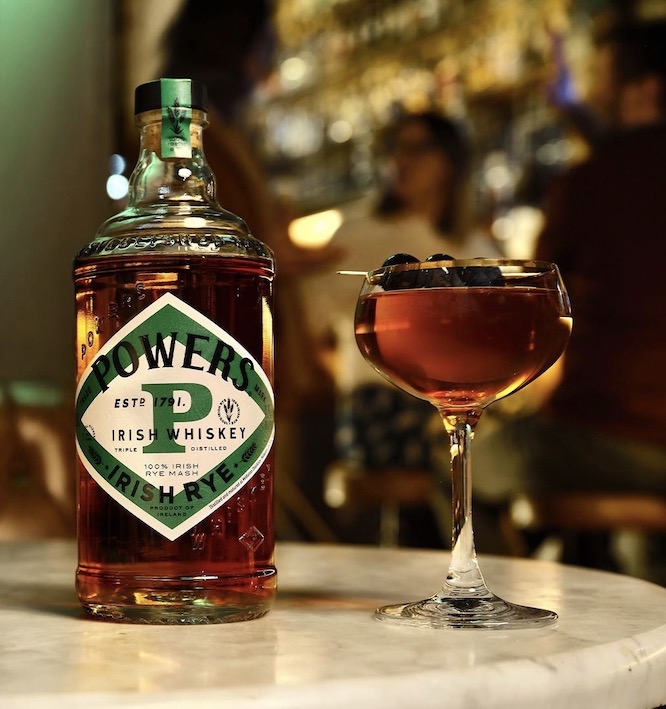 a
triple distilled, non-chill filtered whiskey bottled
at 46.3% alcohol, from malt whiskey matured in
ex-bourbon (39%), and PX Sherry Casks (61%), for six
to seven years. There is also a sixth and
final release of its Single Malt Batch series ($69) ,
with some 15,000 bottles
made with a Tawny Port maturation and with an
additional 1,000 Cask Strength bottles available, at
46.5%.
a
triple distilled, non-chill filtered whiskey bottled
at 46.3% alcohol, from malt whiskey matured in
ex-bourbon (39%), and PX Sherry Casks (61%), for six
to seven years. There is also a sixth and
final release of its Single Malt Batch series ($69) ,
with some 15,000 bottles
made with a Tawny Port maturation and with an
additional 1,000 Cask Strength bottles available, at
46.5%.
POWERS IRISH RYE ($32)—Irish whiskey is
always made with malted barley, except when it is not,
and Powers is made from 100% rye—they claim it’s the
world’s first— aged in American oak, arriving at 43.2%
alcohol. Powers
is, however, no newcomer, having been founded by James
Power in 1791 in Dublin as a distillery. Its
introduction to the U.S. at the Chicago World’s Fair of
1893 gave it great popularity here. It is still bottled
in-house, and they even created their own signature
cut-glass tumbler to serve the spirits in.
❖❖❖
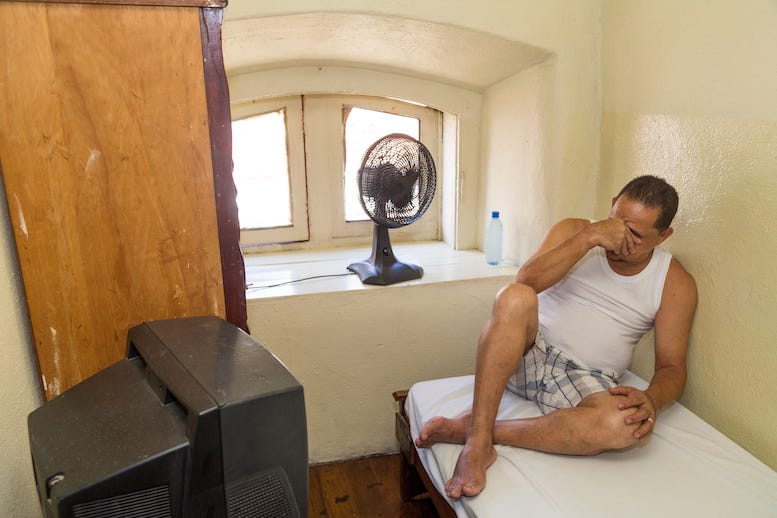
SO YOU DIDN'T EVEN TRY THE FOOD?
"I also stayed in one of the
world’s worst hotels in China. The foyer had a
tarpaulin covered in some unusually dark stains and
the room had bits of wall missing and stank of
urine. I moved to a nearby hotel which was equally
basic but clean, at least, although the TV was
puzzling. It had a single channel showing a military
man laden with medals berating a group of people for
hours on end while they looked shamefaced."—Paul
Merton:
‘I stayed in one of the world’s worst hotels in
China’—London Times (2/28/23)
❖❖❖
Any of John Mariani's books below may be ordered from amazon.com.
 The Hound in Heaven
(21st Century Lion Books) is a novella, and
for anyone who loves dogs, Christmas, romance,
inspiration, even the supernatural, I hope you'll find
this to be a treasured favorite. The story
concerns how, after a New England teacher, his wife and
their two daughters adopt a stray puppy found in their
barn in northern Maine, their lives seem full of promise.
But when tragedy strikes, their wonderful dog Lazarus and
the spirit of Christmas are the only things that may bring
his master back from the edge of despair.
The Hound in Heaven
(21st Century Lion Books) is a novella, and
for anyone who loves dogs, Christmas, romance,
inspiration, even the supernatural, I hope you'll find
this to be a treasured favorite. The story
concerns how, after a New England teacher, his wife and
their two daughters adopt a stray puppy found in their
barn in northern Maine, their lives seem full of promise.
But when tragedy strikes, their wonderful dog Lazarus and
the spirit of Christmas are the only things that may bring
his master back from the edge of despair. WATCH THE VIDEO!
“What a huge surprise turn this story took! I was completely stunned! I truly enjoyed this book and its message.” – Actress Ali MacGraw
“He had me at Page One. The amount of heart, human insight, soul searching, and deft literary strength that John Mariani pours into this airtight novella is vertigo-inducing. Perhaps ‘wow’ would be the best comment.” – James Dalessandro, author of Bohemian Heart and 1906.
“John Mariani’s Hound in Heaven starts with a well-painted portrayal of an American family, along with the requisite dog. A surprise event flips the action of the novel and captures us for a voyage leading to a hopeful and heart-warming message. A page turning, one sitting read, it’s the perfect antidote for the winter and promotion of holiday celebration.” – Ann Pearlman, author of The Christmas Cookie Club and A Gift for my Sister.
“John Mariani’s concise, achingly beautiful novella pulls a literary rabbit out of a hat – a mash-up of the cosmic and the intimate, the tragic and the heart-warming – a Christmas tale for all ages, and all faiths. Read it to your children, read it to yourself… but read it. Early and often. Highly recommended.” – Jay Bonansinga, New York Times bestselling author of Pinkerton’s War, The Sinking of The Eastland, and The Walking Dead: The Road To Woodbury.
“Amazing things happen when you open your heart to an animal. The Hound in Heaven delivers a powerful story of healing that is forged in the spiritual relationship between a man and his best friend. The book brings a message of hope that can enrich our images of family, love, and loss.” – Dr. Barbara Royal, author of The Royal Treatment.
 |
The Encyclopedia of American Food and Drink by John F. Mariani (Bloomsbury USA, $35) Modesty forbids me to praise my own new book, but let me proudly say that it is an extensive revision of the 4th edition that appeared more than a decade ago, before locavores, molecular cuisine, modernist cuisine, the Food Network and so much more, now included. Word origins have been completely updated, as have per capita consumption and production stats. Most important, for the first time since publication in the 1980s, the book includes more than 100 biographies of Americans who have changed the way we cook, eat and drink -- from Fannie Farmer and Julia Child to Robert Mondavi and Thomas Keller. "This book is amazing! It has entries for everything from `abalone' to `zwieback,' plus more than 500 recipes for classic American dishes and drinks."--Devra First, The Boston Globe. "Much needed in any kitchen library."--Bon Appetit. |
"Eating Italian will never be the same after reading John Mariani's entertaining and savory gastronomical history of the cuisine of Italy and how it won over appetites worldwide. . . . This book is such a tasteful narrative that it will literally make you hungry for Italian food and arouse your appetite for gastronomical history."--Don Oldenburg, USA Today. "Italian
restaurants--some good, some glitzy--far
outnumber their French rivals. Many of
these establishments are zestfully described
in How Italian Food Conquered the World, an
entertaining and fact-filled chronicle by
food-and-wine correspondent John F.
Mariani."--Aram Bakshian Jr., Wall Street
Journal.
"Equal parts
history, sociology, gastronomy, and just
plain fun, How Italian Food Conquered the
World tells the captivating and delicious
story of the (let's face it) everybody's
favorite cuisine with clarity, verve and
more than one surprise."--Colman Andrews,
editorial director of The Daily
Meal.com. "A fantastic and fascinating
read, covering everything from the influence
of Venice's spice trade to the impact of
Italian immigrants in America and the
evolution of alta cucina. This book will
serve as a terrific resource to anyone
interested in the real story of Italian
food."--Mary Ann Esposito, host of PBS-TV's
Ciao
Italia. "John Mariani has written the
definitive history of how Italians won their
way into our hearts, minds, and
stomachs. It's a story of pleasure over
pomp and taste over technique."--Danny Meyer,
owner of NYC restaurants Union Square
Cafe, The Modern, and Maialino.
|
 |
 |
 |
 |
 |
 |
MARIANI'S VIRTUAL GOURMET
NEWSLETTER is published weekly. Publisher: John Mariani. Editor: Walter Bagley. Contributing Writers: Christopher
Mariani, Misha Mariani, John A. Curtas, Gerry Dawes, Geoff Kalish.
Contributing
Photographer: Galina Dargery. Technical
Advisor: Gerry
McLoughlin.
If you wish to subscribe to this
newsletter, please click here: http://www.johnmariani.com/subscribe/index.html
© copyright John Mariani 2023
